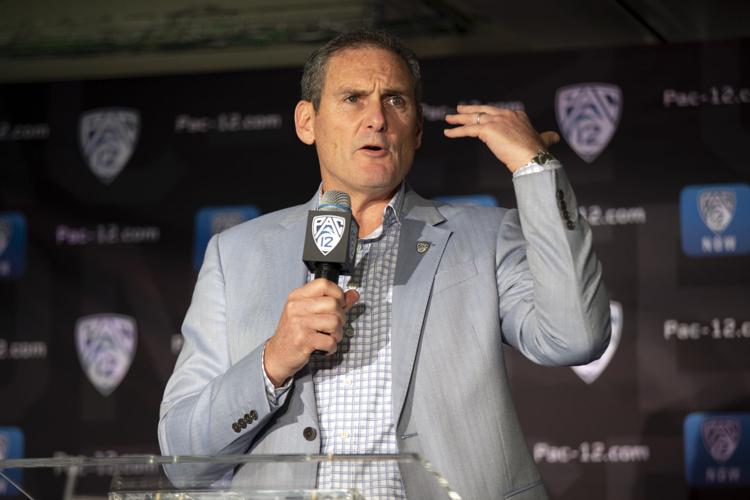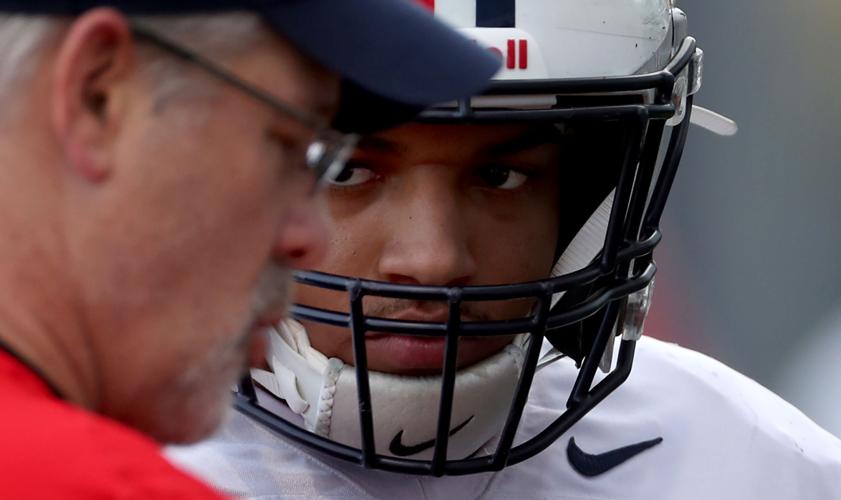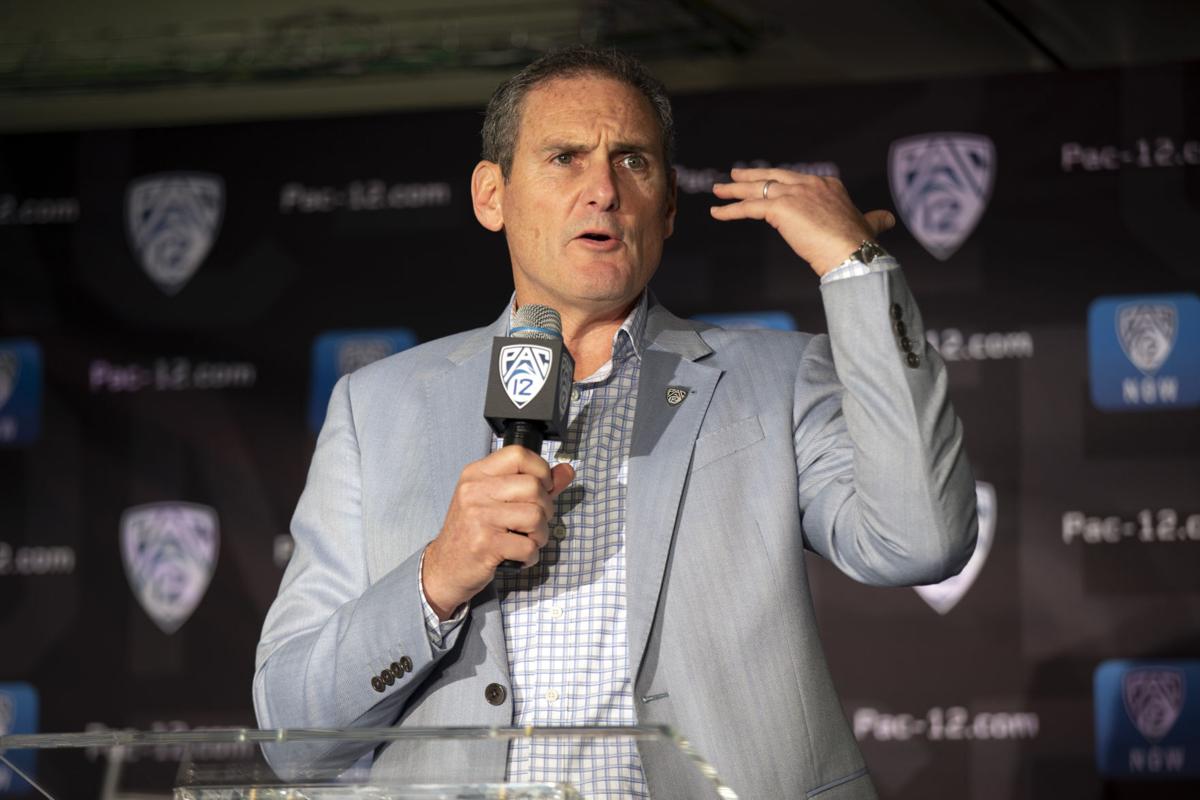College football is in a state of complete chaos. Were you expecting anything less from a sport that rarely, if ever, presents a truly unified front?
A day after the Pac-12 and Big Ten conferences announced they were postponing all fall sports for the remainder of 2020 because of the coronavirus pandemic, the Big 12 released its revised football schedule. Among the so-called Power Five leagues, the Big 12, ACC and SEC continue to push forward with plans to play — even after their counterparts in the Pac-12 and Big Ten deemed fall competitions too big a risk.
“The virus continues to evolve, and medical professionals are learning more with each passing week,” Big 12 commissioner Bob Bowlsby said Wednesday in a news release. “Opinions vary regarding the best path forward.
“Ultimately, our student-athletes have indicated their desire to compete in the sports they love this season, and it is up to all of us to deliver a safe, medically sound and structured academic and athletic environment for accomplishing that outcome.”
The Big 12 has committed to administering three COVID-19 tests per week for contact sports, plus EKGs and other cardiac exams should a student-athlete test positive — measures the conference indicated it was unable to implement to conduct a fall season.
Simply put, university leaders in the Pac-12 and Big Ten believe there are too many unknowns to transition from controlled workouts to full-squad scrimmages and games. As a result, all sports, including basketball, are on the shelf until 2021.
Are the Pac-12 and Big Ten doing the right thing? Will the Big 12, ACC and SEC ultimately have to shut down?
The announcements by the former provided some clarity Tuesday, but many questions remain unanswered. Below we attempt to answer some of them, including the implications of the postponement for the Arizona football program.
How surprising was the Pac-12’s decision to halt all sports until 2021?
Mildly. The outcome seemed inevitable given the persistent spread of the virus in the United States, including several locations within the Pac-12 footprint. But the timing felt odd, coming less than two weeks after the Pac-12 released its revised schedule (July 31) and more than six weeks before the start of that proposed all-conference slate (Sept. 26).
Commissioner Larry Scott said conference medical experts and decision-makers did not see the situation improving over the next few weeks, so it made little sense to pause and reconsider sometime later this month. In addition, recently discovered information linking COVID-19 to myocarditis, a treatable but potentially fatal heart condition, undoubtedly spooked university leaders.
The Athletic reported that the Big Ten had become aware of “at least 10 players who have myocarditis, an alarmingly high number for an otherwise rare condition, on the eve of preseason camp.” That’s what spurred the Big 12 to institute additional tests for positive cases.
Why couldn’t players and/or their families sign liability waivers absolving universities of any responsibility?
The parents of three Wildcats — quarterback Grant Gunnell and brothers Brenden and Colin Schooler — told the Star they’d be willing to sign waivers in order to play this fall. But legal experts will tell you it’s not that simple.
Attorney Tom Mars, known mainly for representing student-athletes in eligibility cases, told Sports Illustrated that conferences that decide to play “will be taking a ridiculously high risk they may soon regret.”
“I know and have talked with some of the best plaintiff’s lawyers in the country this week,” Mars said, “and they’re praying the SEC, Big 12 and/or the ACC are greedy enough to stay the course.”
Arizona State athletic director Ray Anderson said liability waivers never were an option for the Pac-12.
“Our responsibility is not about liability. It’s about accountability to these student-athletes and their families,” Anderson said. “We can’t waive our duties and obligations to protect them. That’s not what floats the boat in this conference. The science and medicine say we can’t allow you to go forward right now, so we won’t.”
What athletic activities are allowed?
The UA football team shifted from voluntary strength and conditioning to a mandatory 20-hour-a-week program this past Friday, and the Wildcats will continue to participate in that program until they’re told otherwise.
The schedule includes weightlifting, walk-through practices — the first chance coaches have had to work with players in person since early March — and meetings via Zoom. The coaching staff views the walk-throughs as valuable teaching opportunities, and player enthusiasm has been high thus far.
The Pac-12 said it would honor all student-athletes’ scholarships. UA student-athletes will continue to receive all the usual perks, including meals, and they’ll be tested weekly for COVID-19.
The current UA roster includes all but a handful of the 34 newcomers expected to arrive on campus the weekend of Aug. 1-2. The staff believes that being around the program offers those players multiple benefits, including access to testing, nutrition and coaching.
What are the chances that Arizona or another Pac-12 school could conduct the equivalent of spring practice in the fall?
The league postponed all “sport competitions” Tuesday; that decree doesn’t necessarily apply to practice. However, resuming what the league considers “contact/competition” would require meeting at least the following six criteria, per the recommendations of the Pac-12 Student-Athlete Health and Well-Being Initiative:
- COVID 19 is not actively spreading uncontrolled among the school community
- Access and ability to complete cardiac evaluation on those who do test positive
- Testing access and capacity to satisfy testing recommendations, including the ability to test within 24 hours of competition and have results before that competition
- Capability to isolate new positive cases and quarantine high-risk contacts
- Adequate local health-care capacity as determined by local public health officials
- Ability to provide adequate care for the institution’s student-athletes
If all those conditions were met by 2021, what might a spring season look like?
The Pac-12 always viewed a spring alternative as a last resort and thus did not offer any possible plans during a video news conference Tuesday.
Several media pundits have posited concepts for a spring season. In all likelihood, it would have to be abbreviated — think 6-8 games — and conclude by May to give players a chance to recuperate for the 2021 fall season, which conceivably could be pushed back if a spring season happens.
While a spring season provides hope for fans and players, it would be fraught with challenges. One is cramming two seasons, or at least 1½, into one calendar year. Another is accommodating NFL draft hopefuls.
The lead-up to the draft typically begins with all-star showcases in January, followed by the scouting combine in February, on-campus pro days in March and the draft in late April.
Would the NFL be willing to change that schedule? Would any possible draftee be willing to risk injury to play in a spring season consisting of 6-8 games?
Several projected first-round picks already have opted out of the 2020-21 season to prepare for the draft. Arizona has no such prospects, but it has some potentially draftable seniors, including the Schooler brothers and cornerback Lorenzo Burns.
Whether those players would participate in a spring season remains to be seen. Before the Pac-12 announcement became official, the Schoolers’ father, Tom, indicated his sons likely would eschew a spring season to prep for the draft.

Linebacker Tony Fields II had 287 tackles over 37 starts during his three years with the Wildcats. He had 94 tackles in 2019.
Colin Schooler’s longtime cohort at linebacker, Tony Fields II, left the UA last month as a graduate transfer. He committed to West Virginia, which plays in the Big 12. That move looked prescient when the Pac-12 nixed football Tuesday.
About one-fifth of Arizona’s scholarship roster consists of fourth- or fifth-year seniors who were expected to play sizable roles in 2020. All of those players will have decisions to make before spring.
The NCAA did provide some clarity about eligibility Wednesday. The Division I Council recommended fall-sport student-athletes get an extra year of eligibility if they opt out or have seasons cut short because of COVID-19; or if they participate in 50% or less of their team’s games. How the latter would apply to a shortened spring season is unclear. Roster limits would have to be adjusted if seniors are awarded additional eligibility.
Eligibility was the biggest question players had for Kevin Sumlin and his staff when they discussed the Pac-12’s announcement during virtual team meetings Tuesday afternoon.
What impact does the postponement have on recruiting?
Minimal, if any. Schools haven’t been able to do any in-person recruiting, on or off campus, since the pandemic shut down NCAA sports in March. That “dead period” will continue through at least Sept. 30.
It hasn’t stopped Sumlin and his staff. Since May 5, Arizona has received verbal commitments from 23 prospects. The latest came Tuesday and Wednesday from a pair of in-state prospects in the class of 2022: receiver Kyion Grayes of Chandler High School and quarterback Treyson Bourguet of Salpointe Catholic.
A lot can, and undoubtedly will, change between now and December 2021, when Grayes and Bourguet first could sign with the UA. But it’s a positive development for the program to experience some success with players from schools that have shunned Arizona in recent years, no matter the circumstances.






